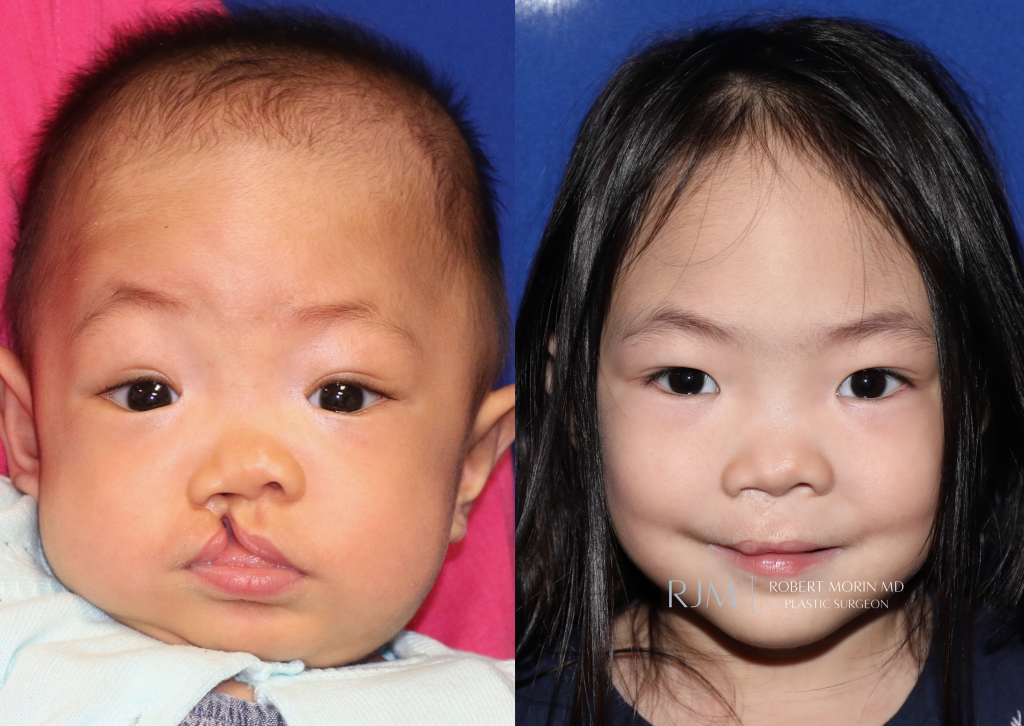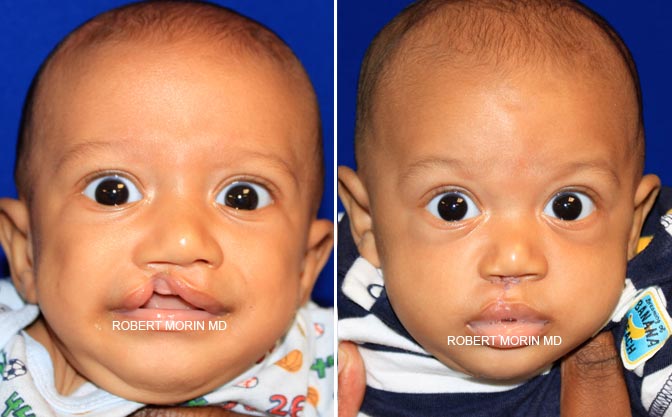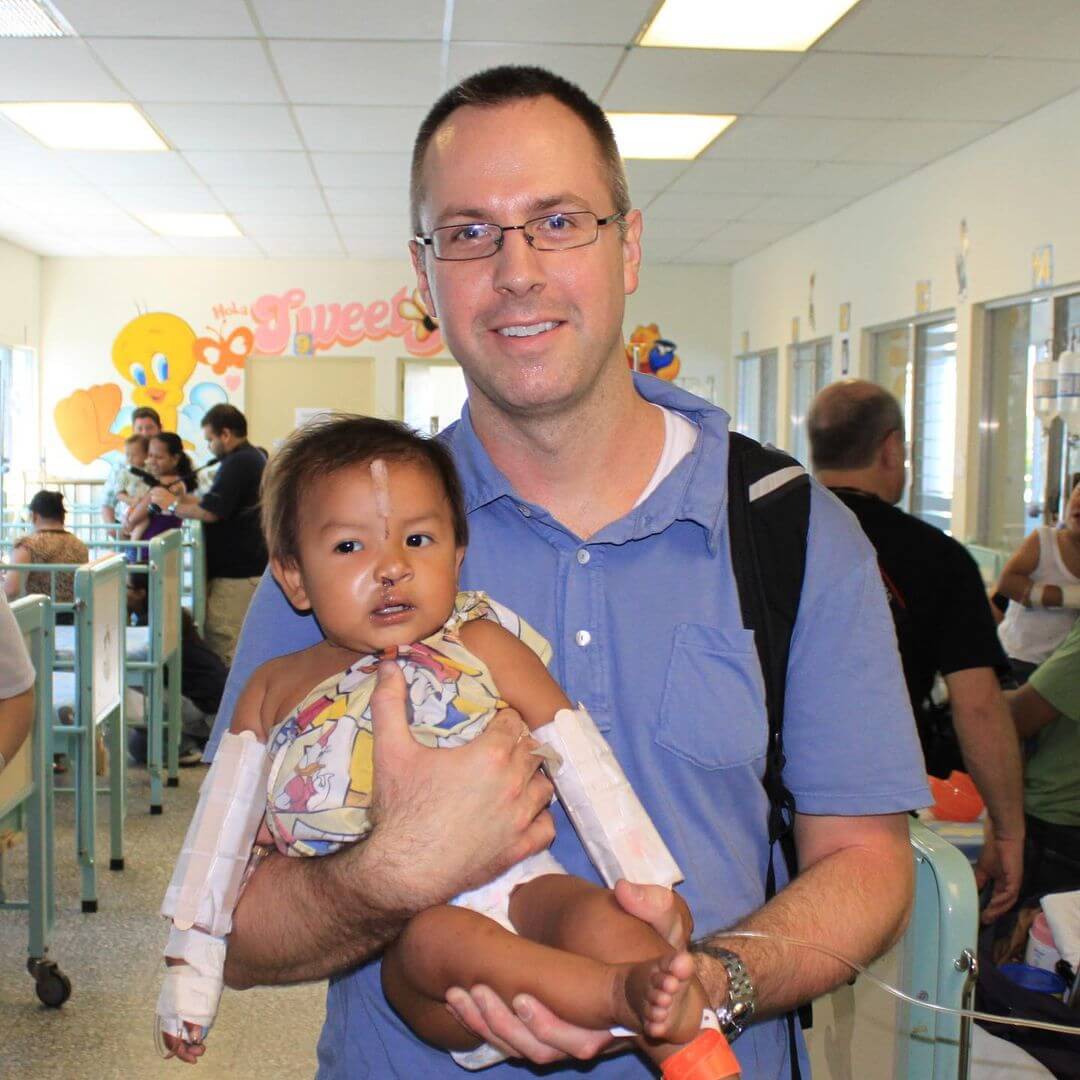
Understand the latest in cleft lip and palate conditions and surgery under the expertise of Hackensack, New Jersey’s premier craniofacial surgeon and pediatric plastic surgeon, Dr. Morin.
Cleft lip and cleft palate (orofacial clefts) are congenital birth defects that occur due to the improper formation of the lip and mouth during the early stages of a baby’s development. During the first six to eight weeks, tissue grows from different areas of the baby’s head and eventually meets to fully form the facial features. If the tissue does not fuse properly, the result is a cleft or a gap.
Affecting about 1 in 1,50 babies, a cleft lip is one of the most common birth defects in the United States. It is characterized by an opening in the upper lip, which can vary in size: from a small slit to a large gap that extends into the nose. The gap typically occurs on one or both sides of the lip and, very rarely, in the middle of the lip.
A cleft palate is an opening in the roof of the mouth, which creates a connection between the mouth and the nose. A cleft palate increases the risk of chronic ear infections.
Because the lip and palate form separately, a cleft lip and cleft palate can occur independently or together. The precise cause of orofacial clefts is unknown, however, it is thought to be a combination of genetic and environmental factors.

Several genes are linked to the development of cleft lips and cleft palates, namely the gene IRF6, followed by genes MSX1, PVRL1, and TBX22. Changes in these genes’ expressions correlate with clefting.
Cleft lips and palates are known as polygenetic, meaning the development of orofacial clefts requires multiple genes to change expressions and/or be influenced by environmental conditions, resulting in a cleft.
Van der Woude Syndrome is a specific genetic condition known to trigger the development of a cleft lip and palate, along with distinct additional lower lip grooves, bumps, or “pits.” Van der Woude Syndrome develops from mutations within the IRF6 gene that typically occurs in early pregnancy.
Certain environmental factors are associated with a higher risk of developing cleft lips and palates. These factors include folic acid deficiency, smoking, alcohol and substance consumption, anti-seizure medication, and prolonged exposure to specific chemicals.
Orofacial clefts can result in feeding and dental problems, speech impediments, and, if not corrected promptly, psychological effects. Fortunately, Dr. Morin can treat both conditions early and effectively, with surgery, at his clinic in Hackensack, New Jersey.
Both cleft lip and palate are best treated within the first year of a baby’s life. Depending on the nature of the cleft lip and/or palate, it may take several years of treatment and multiple surgeries, including rhinoplasty, to fully address all of the issues.
During surgery, Dr. Morin will repair and close the cleft lip and/or palate. The basic repair of a cleft lip involves rotating and advancing the divided segments and suturing the lip skin and muscle. To fix a cleft palate, Dr. Morin will connect the palatal muscles and reposition the soft tissues.
In most cases, nose surgery will be needed at some point. When a male reaches 18 years or a female reaches 16 years, a cleft lip rhinoplasty and septoplasty can be performed to reshape the nose and straighten the septum.

*Results may vary

Dr. Robert J. Morin is a board-certified craniofacial and pediatric plastic surgeon with surgical specialties in cleft palate and lip repair, making him one of today’s best cleft-lift surgeons in the U.S.. He combines advanced surgical expertise with an aesthetic hand and distinct pediatric-focused care. It’s his honor to work with children and their families.
Ready to start looking your best? We offer virtual and in-office consultations.
Bone is an excellent material to use when performing craniofacial surgery. It is strong and has the benefit of naturally becoming incorporated into the defect in which it is placed.
Bone grafting is similar in concept to fat grafting, in that, bone is taken from one area of the body and is securely placed into another area of the body to correct a deformity. Bone grafting is commonly used in patients with cleft lips and palates to reconstruct their upper jaw. Other uses include reconstructing facial defects following trauma or cancer resection.
The use of a patient’s own bone is usually preferred to the use of artificial material in craniofacial reconstruction due to a lower risk of potential complications.
New Jersey pediatric surgeon, Dr. Morin specializes in cleft lip and palate treatment. Repairing a cleft lip and palate will improve the functionality to the lips and mouth. Cleft lip and palate surgery in NJ helps your child grow and develop at a healthier pace. Some risks and complications can occur as a result of surgery, which include:
While cleft lip complications are rarely life-threatening, they can impact quality of life, especially if untreated or improperly repaired.
Common challenges may include the following:
Rhinoplasty is often essential for children with cleft lips or cleft palates to correct nasal asymmetry and correct breathing, improving both the appearance and function of the nose.
A cleft lip nose job will focus on making alterations to the patient’s nostrils, nasal airways, bridge, and nose tip through bone and cartilage grafts. Performed by specialists like Dr. Morin, cleft lip rhinoplasty ensures a nose’s most natural appearance during a patient’s formative adolescent years while also addressing any airway concerns.
Families should consider this intervention as part of comprehensive orofacial cleft care. A cleft lip or palate nose job ultimately provides natural facial symmetry and supports long-term physical and emotional well-being for the patient. It is typically performed between the ages of 15 to 18.
The surgical care of babies and children demands a unique approach. Dr. Morin is a board-certified plastic surgeon specially trained in pediatric plastic surgery. Younger patients are different from adults. As a result, they require a calm, compassionate, and experienced surgeon who knows how to interact with them. In the case of orofacial clefts, Dr. Morin understands that surgical skill and timing are essential for the successful treatment of the conditions.
Dr. Morin’s expertise in repairing cleft lip and palate has taken him on humanitarian surgical missions to the Philippines, Guatemala, Colombia, Hatti, and Mauritius, where he has performed reconstructive procedures on infants, children, and young adults, ages 3 months to 18 years.
Cleft lip and cleft palate are two distinct but related conditions. A cleft lip involves a gap or opening in the upper lip, which can range from a small notch to a complete split that extends into the nose. A cleft palate, on the other hand, is a gap in the roof of the mouth (palate) that can extend into the nasal cavity. While cleft lip affects the lip, cleft palate affects the palate and can sometimes involve both the lip and palate.
Yes, the conditions can occur independently of each other. Some children may have only a cleft lip, while others may have only a cleft palate. However, it is also possible for a child to have both conditions simultaneously. The specific presentation varies from child to child.
Common signs of cleft lip include a noticeable gap or split in the upper lip, which may be apparent at birth. For cleft palate, signs may include difficulty feeding, nasal congestion during feeding, and a gap in the roof of the mouth that may be visible or detected through feeding difficulties. In some cases, cleft palate may be less visible but can affect speech and feeding as the child grows.
Treatment typically involves a multidisciplinary team approach including surgery, speech therapy, and orthodontics. The primary surgical treatment for cleft lip is usually performed around 3 months of life. Follow-up care includes monitoring speech development and dental health.
Cleft lip repair may require more than one surgical procedure. The first surgery typically occurs between 3 and 4 months of life. Cleft palate repair generally happens around 12 months of life, but additional surgeries might be needed as the child grows, especially for speech improvement or dental alignment.
Cleft lip and/or palate surgery should be performed within the first year of life. If there are extenuating circumstances, surgery can be performed later in a child’s life.
Children may experience speech and language delays and early intervention with speech therapy can significantly improve outcomes. Occasionally, additional surgery may be required.
For many patients, long-term care includes regular visits to their pediatrician, surgeon, speech therapist, and dentist. This ensures that your child’s growth, speech development, and dental health are on track. Additional surgeries or therapies may be needed as your child grows.
Providing emotional support involves being understanding and patient as your child goes through surgeries and therapies. Encouraging open communication, celebrating progress, and involving your child in their care can help build their self-esteem. Dr. Morin also recommends connecting with support groups for families affected by the condition as they provide valuable resources and comfort.
Yes, ultrasound can often detect cleft palate during pregnancy, particularly during the second trimester when the baby’s features are more developed. A high-resolution ultrasound can reveal the presence of a cleft lip as early as 13 weeks of gestation. However, detecting a cleft palate can be more challenging, as it involves visualizing the roof of the mouth, which may be less obvious on standard ultrasound images.
Cleft lip and palate are not considered disabilities, but they can lead to challenges that might impact a person’s quality of life and functioning. The conditions may require multiple surgeries, speech therapy, and other interventions, which can affect daily activities. With appropriate medical treatment and support, most individuals with cleft lip and palate lead healthy and fulfilling lives.
After cleft lip and palate surgery, children experience significant improvement in their quality of life. According to a 2022 study, most parents report better psychosocial integration and a positive impact on the child’s psycho-emotional well-being, leading to enhanced social interactions and self-esteem.https://www.ncbi.nlm.nih.gov/books/NBK564326/
Ready to start looking your best? We offer virtual and in-office consultations.